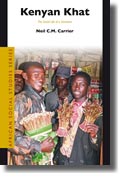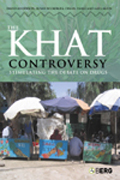
you are here: home > research projects > khat nexus
|
 |
|
|
The Khat Nexus: Transnational Consumption in a Global Economy
Khat is a plant based psychoactive substance that has recently become globalised. The international trade has benefited from (i) the integration of transport facilities allowing khat to be marketed while fresh; and (ii) the dispersal of refugees from the Somali civil war. While Somalis are the most prominent users, khat is exported mainly by Kenya and Ethiopia, where it provides the foundation for rural livelihoods, and a source of tax revenue and foreign exchange. Over recent years khat has become the second most important export cash crop in Ethiopia. After reviewing the evidence, including this research, the Home Office has confirmed in January that khat is to remain a licit substance in the UK.
This project ran from October 2003 to March 2005
view this project's findings summary sheet [pdf]
Project team:
Award Holder:
David Anderson (Oxford University)
Axel Klein
Susan Beckerleg
Neil Carrier
Degol Hailu
Contact
Dr David M Anderson
St Anthony’s College
Woodstock Road
Oxford
OX2 6JF
+44 (0)1865 284 735
david.anderson@sant.ox.ac.uk
Publications include:
|
The Khat Controversy: Stimulating the Debate on Drugs The first study of this contested drug, The Khat Controversy provides a concise introduction to the issues surrounding khat usage and suggests how policymakers should address them For further information visit the book's page with Berg
|
 |
Kenyan Khat: The Social Life of a Stimulant For further information visit the book's page with Brill
|
Anderson D. and Carrier N. ‘ ‘Flowers of Paradise’ or ‘Polluting the Nation’? Contested Narratives
of Khat Consumption’, in Brewer J. and Trentmann F.
(eds), Consuming Cultures, Global Perspectives:
Historical Trajectories, Transnational Exchanges
(Oxford and New York: Berg, 2006), chapter six.
Klein A. and Beckerleg S. ‘Building Castles of Spit – The
Role of Khat Chewing in Worship, Work and Leisure’,
in Goodman J., Lovejoy P. and Sherrat A. (eds),
Consuming Habits (London: Routledge, in press).
Project outline
Following is the text of the original project outline:
SUMMARY
Khat (qat) is a stimulant grown and consumed in the Red Sea littoral. It has recently expanded into a global market, provoking calls for its prohibition. Khat now occupies an ambiguous category - banned in some countries, whilst legal others. This project examines the economic and social aspects of this dramatic expansion, looking at the globalization of khat consumption in terms of international debates about drug use.
OUTLINE OF PROJECT
The importance of khat (catha edulis) cultivation to the economies of the Red Sea region cannot be overstated. In Ethiopia and Yemen, khat is the principal export crop, and each year over the past decade cultivation has increased to meet expanding internal and international demand. Once limited to the Red Sea littoral, khat is now an international commodity, traded and consumed in the cities of Western Europe and North America. Each day cargo flights carry freshly harvested khat from Yemen and eastern Ethiopia to London, Toronto, Rome and other cities in the developed world. And throughout the Islamic diaspora, from Cape Town to Cairo and from Tangiers to Jakarta, khat consumers are to be found. With this globalisation of khat consumption, the stimulant has found new markets, both within the region of production and internationally. In response to increased demand, more and more farmers in the red Sea region are giving up other crops to concentrate upon khat. This book will chart the trajectory of this expansion, mapping out the emergence and growth of an international market, and examining the impact of these changes upon local patterns of consumption in the Red Sea region.
The expansion of khat production and consumption in recent years has promoted heated public debates regarding its effects upon consumers. In Ethiopia, Yemen and Kenya, CBOs (Community-Based Organisations) have campaigned for the prohibition of khat, arguing that the culture of indolence associated with its consumption undermines national productivity; that its habituation is especially damaging to the young; and even that it represents an aspect of Islamic culture that is polluting the lives of Christians. International agencies, including the UN, have also debated the need to prohibit khat as an element of drugs control.
Within the region of eastern Africa, khat has been banned in Eritrea, Tanzania and Somalia, and it is also illegal in several other countries, including the United States of America and Sweden. The partial international prohibition of khat has significant effects upon the marketing of the crop and the response of producers to its availability.
This is the first analytical study of the chain of production, distribution and transnational consumption of khat. The economics of the crop, the factors affecting the market, and the cultures of consumption associated with khat will be integrated in this study, so that the social and economic aspects of the khat nexus can be viewed holistically and linked to questions of social policy and legislative control. Our study will assemble detailed local and global empirical data on the consumption of khat, including data on the age, gender and wealth of consumers. We will also evaluate the prohibition debates in various countries, and among international agencies, and assess the likely impact of extended prohibition upon production and consumption. The study will assess trends in local and global consumption of khat, and compare cultures of consumption in traditional (local) and new (global) settings. We will chart the historical development of the khat economy as a sector of agricultural production through a focus upon specific case studies (from Ethiopia, Yemen and Kenya), and as a site of consumerism (in Addis Ababa, Djibouti, Sennar, Rome, Toronto, Copenhagen and London).
The existing literature on khat is not extensive and has a predominantly local focus. The most important themes that have been developed in this body of work include culturally specific descriptions of the social behaviour of consumers, medical and cultural aspects of habituation, and the effects upon young consumers. None of these studies has integrated a regional view of the khat nexus, and only Weir (1985) has made a preliminary attempt (for highland Yemen only) to relate patterns of consumption to changes in production. There has been only minimal study of the wider diasporas of khat consumption beyond the Red Sea Littoral. This book therefore marks a significant new departure in our understanding of khat in a wider context.
KEY QUESTIONS
- To assemble detailed local and global empirical data on the consumption of khat, including data on the age, gender and wealth of consumers;
- To evaluate the prohibition debates in various countries, and among international agencies, and to assess the likely impact of extended prohibition upon production and consumption;
- To assess trends in local and global consumption of khat, and to compare cultures of consumption in traditional (local) and new (global) settings;
- To chart the historical development of the khat economy as a sector of agricultural production, and as a site of consumerism (in what ways has the social behaviour associated with khat consumption changed?);
- To evaluate the economics of khat production within the agricultural sector of each producing area within the study;
APPROACH
There will be four main components to the research programme:
- Archival Research, Desk Study and Project Coordination
This will involve the compilation of a thorough bibliography of published literature, grey literature, and archival sources on khat, both current and historical. Recent archival sources will be accessed through web-based links to international agencies. Older archival materials will be examined in London, Addis Ababa, Nairobi and Djibouti. These elements of the study will be completed by the Project Leader, Dr David Anderson, a historian. - Diaspora Fieldwork
This will involve the identification of consumers in Europe and North America, and the tracking of the supply chain through importers, wholesalers and retailers. This research will be conducted by an expert in drugs policy, Dr Axel Klein, in coordination with research assistants in four diaspora centres - London, Rome, Copenhagen and Toronto. - Local Fieldwork, Yemen & Kenya
The Yemen research will be based in a production area close to Sennar, the Kenya research near to Meru Town. Local research assistant will be employed in each location to log market prices, and to survey producers and consumers. Field interviews will be conducted with farmers, traders and consumers, and local CBOs, government agencies and welfare workers will be consulted. This research will be conducted predominantly in local languages (Arabic and Swahili) by Dr Susan Beckerleg, an expert in the social impact of drug use in this region. - Local Fieldwork, Ethiopia & Djibouti
The research in Ethiopia and Djibouti will be led by Degol Hailu, an economist, and organized in parallel with the studies in Yemen and Kenya. Two production sites will be studied in Ethiopia, one in the traditional heartland of khat production close to Harar, the other in a new and expanding area of production at Wondo Ghenuet. Djibouti plays a pivotal role in the regional marketing of khat. Here trade and customs records examined. Djibouti is also the most significant urban centre of consumption.
OUTCOMES
The project will result in the publication of a major monograph, co-authored by the project team, along with several articles in relevant academic journals. Workshops in Nairobi, Addis Ababa and London will be used for the dissemination of the results of the project, and the documentation collected for the study will ultimately be deposited with the NGO Drugscope, where they can be made available to other scholars.
On the policy side, the study of the transnational consumption of khat has the potential to make a significant contribution to the development of theory in relation to drugs prohibition. The current position of khat, which is legalised in some domains but banned in others, presents a model of a fragmented international market where legislative measures and attitudes are contradictory. Similar historical processes can be described in relation to other drugs, and is replicated in the contemporary treatment of cannabis as some governments now move toward the liberalization of controls. Discussion of the likely impact of liberalisation is prominent in the literature on drug use and control, and we will use the example of khat to address this question comparatively.
![]()


